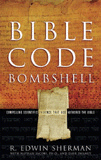| |

Bible Code
Research Guidelines
We are often asked what sort of guidelines we use when researching the codes. After all, it's a scientific process that should have clear, concise guidelines.
Bible code research has grown in recent years from the hodge-podge searching of single words accompanied by outlandish predictions of the future (such as Drosnin-type codes), to a much more sophisticated process of statistical analysis accompanied by the subtleties of translating lengthy equidistant letter skips (ELSs) from the Hebrew into English or other languages.
One of our frequent contributors to Bible Code Digest (BCD) is Moshe Aharon Shak. In his book Bible Codes Breakthrough, two in-depth chapters are devoted to guidelines for code research. We will not go into this topic with as much depth, but will attempt to draw a basic outline for guidelines that are necessary to finding statistically significant codes and to avoiding the pitfalls of short, statistically insignificant codes.
Getting Started
- Select a topic of interest.
- Draw up a list of key search words and phrases. (Be sure to be realistic about this step and throw out any words or phrases that are really not connected closely with the topic.)
- Prioritize the search terms.
- The terms must now be translated or transliterated into Hebrew in order to conduct the searches. (Some knowledge of Hebrew is necessary complete this and the following steps, otherwise a Hebrew scholar should be consulted.)
- Begin at the top of the list and conduct searches to find the matrix. Many researchers only search in the Torah (the first five books of the Bible), but at BCD, we often search the entire Tanakh (Old Testament).
- Examine the terms with the lowest skips to find a matrix. The lowest skips will be more significant.
- As a bare minimum, only accept terms at 20:1 odds (R-Value of 1.30) or more.
- After locating the matrix, examine the surface text of the matrix to see if there is a relationship between the topic of the codes and the topic of the surface text. (We have discovered that there is often a relationship between the two.)
- If you so desire at this point, you can add more terms to your search based on your findings. Also consider adding synonyms.
- Look to see if any of the terms make sense read in the opposite direction. (Codes can run in both directions.)
Looking for Extensions
At BCD, our interest is in finding and evaluating long ELSs. We discourage just searching for individual words and concluding from those findings that they mean something as a whole. In his book The Bible Code, Michael Drosnin introduced many people to this method of searching for codes. Unfortunately, it's likely that this type of finding could be found in almost any passage. Therefore, we do not believe that it is statistically significant. Short ELSs appear frequently in any Hebrew text. So, to find something improbable, we need to find ELSs that are each at least eight to 10 letters long (in Hebrew). This requires taking the original search findings and examining them for extensions. The following are the steps for doing this process.
Take the individual terms and look at the letters before and after the term at the same skip.
[preceding letters] [Initial ELS] [succeeding letters]
Four possible things can happen:
- [Nothing] [Initial ELS] [Nothing]
- [Nothing] [Initial ELS] [Extension]
- [Extension] [Initial ELS] [Nothing]
- [Extension] [Initial ELS] [Extension]
To shorten the notation, these outcomes are denoted by:
- NIN
- NIE
- EIN
- EIE
Once an N occurs, the search process is over on that side of the initial ELS. But if an extension is found, there is an opportunity to find yet another extension. So if NIN happens, the search is over. But if NIE happens, two things could result from the additional search (NIEN and NIEE). If NIEN occurs, the process is over. But if NIEE occurs, two things could result from the additional search (NIEEN and NIEEE), and so forth . . .
Additional information on the probabilities of finding extensions can be found in Appendix Seven of Bible Code Bombshell.
Evaluating the Matrix
After finding a matrix of terms and examining the terms for extensions, it's time to evaluate that matrix for significance. Take into consideration the following in determining the significance of a matrix.
- The skips of the terms (the lower, the better)
- The correct spelling of the Hebrew words
- The gender of the terms (gender is significant in Hebrew)
- The grammar and sentence structure of the Hebrew
- The repetition of terms (this emphasis of terms within the matrix can add to the significance)
- The arrangement of the terms in the matrix. Is there anything interesting about it? Do terms intersect, or run along one after another in an interesting order? Examine the arrangement of the terms for any additional meanings.
- The story (does the matrix tell a story about the topic?)
- The surface text (is there a relationship between the topic of the surface text and the codes in the matrix, and what significance does the relationship have?)
- The odds (20:1 odds and R-Value of 1.3, or more)
Clusters
As the collection of matrices grows, the discovery of clusters can be made. Clusters are a group of codes with varying skips that all pass through the same surface text. Clusters could almost be considered a three-dimensional phenomenon.
Final Comments
Perhaps the most important thing to do after finding a matrix is not to jump to any conclusions about your findings. This field of research is plagued by people jumping to conclusions and making predictions based on statistically insignificant findings.
In addition, we recommend that all the codes be kept and reviewed, whether you agree with them or not. As we discussed in our article, Do Longer Code Express Viewpoints?, you may find a code you disagree with, but that doesn't necessarily make it a bogus code.
Lastly, we encourage our readers not to study the codes looking for predictions, but rather to enjoy the process as additional evidence of God's authorship of the Bible. Codes have been described as His Fingerprints on the Word, another facet of His omniscience.
|
Enjoy finding your own Bible codes.
Bible code search software is available in our online store.
Subscribe Free!
By signing up to be a member of The Isaac Newton Bible Research Society, you will have access to more than fifteen years of research by our team of Bible code researchers.
Sign up to be a member today.
|
|
Now available, donate using PayPal ↓
 
Bombshell examines two massive, recently discovered clusters of codes in the Hebrew Old Testament. To read more about Bombshell, click here, or click below to order from Amazon today!
 
|





